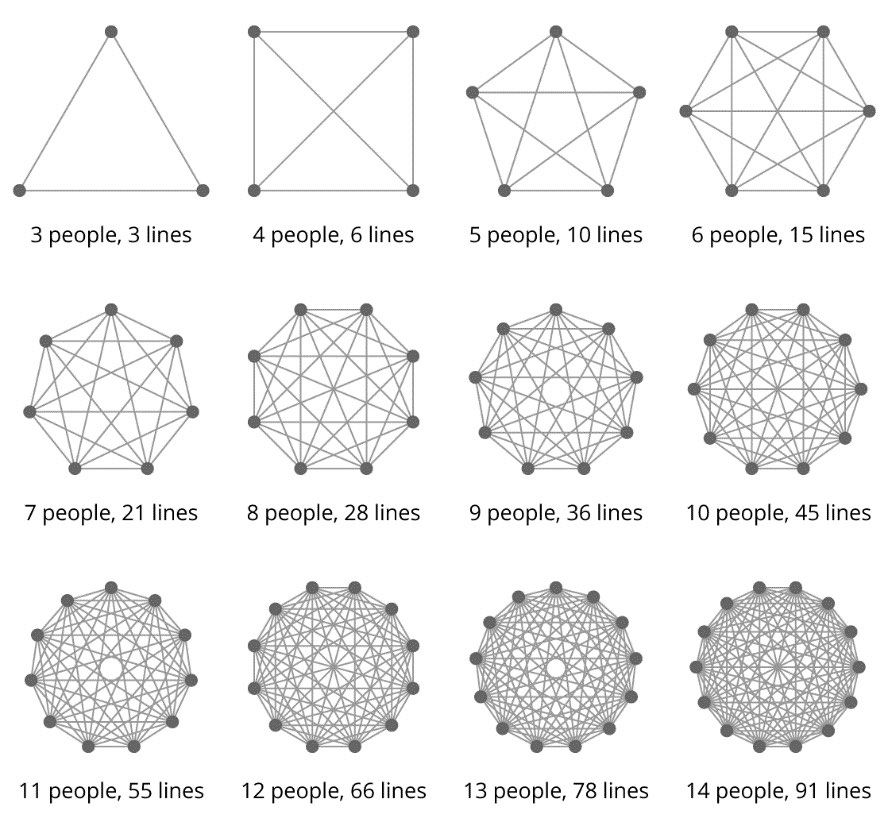Managing larger teams is harder now than ever before. It’s not just you. It really is harder than it was before.
Of course, it was never easy, but in the beginning it was just you and you spent your time trying to solve business problems.
Eventually, you hired some help to take some of the simple tasks off your hands and you moved faster.
But now you have even more help and you’re not moving as fast. You’re spending more time handling internal issues instead of growing your business.
This is why process documentation is crucial.
Again, this isn’t your imagination. I’ve managed remote workers my entire professional career. Everything from consulting on a one man apartment locating business, to multiple teams of soldiers in Iraq, to running a team of 70+ outworkers for a website that does $2 Billion in revenue a year.
The skills that let you manage one situation don’t automatically scale up to the next level.
Why is it so hard to manage the larger teams?
If hiring one remote worker gets things done faster, it seems like hiring more would be a no-brainer. That kind of thinking is very common.
Unfortunately, as with much common thinking, it is wrong. It violates Brooke’s Law which roughly states “Adding manpower to a late project makes it even later.” Another, more down to earth way to say it, “9 women can’t make a baby in a month.”
But why? How can more people make the same amount of work harder?
It’s because doing the work with more people requires coordination and that is work itself. It’s not the same amount of work.
Adding more people to a network doesn’t increase the coordinating challenges linearly. It increases those challenges geometrically.
Coordinating 4 people is literally twice as complicated as coordinating 3 people. If that sounds crazy, check out this image explaining it.

As you can see, you don’t need a very big team before keeping everyone interacting seamlessly can be extraordinarily complex. Even if you’re successful, it takes a lot of time and energy and slows you and your business down.
That is just the obvious, direct challenge of managing a large team of remote workers. When you have to spend your time managing internal team issues, you also lose sight of what is happening outside and across your industry.
You aren’t talking to your customers or learning about your market. A larger team can make day-to-day issues more challenging, it can start to impact your ability to handle strategic issues.
How do you move forward?
It’s obvious that your ability to grow is limited if you don’t get help. But it’s also obvious that hiring more help can also limit your ability to grow.
So what is someone who wants to grow supposed to do?
The good news is that it is possible to grow your team in a way that doesn’t hold you or your business back.
Taking process documentation seriously
Documenting processes for remote workers is not new advice. Experts have been recommending it for a long time now.
Unfortunately, process documentation is similar to the terms and conditions on websites. Everyone pretends to read them but most people don’t take them seriously.
With a small team, that can be annoying or keep you from peak productivity. With a large team, ignoring process can be simply disastrous for productivity.
Without conscious effort on your part, neither you nor your team will see the benefits of having documented processes.
People’s first inclination when given directions is to ignore them. Whether it is board games or IKEA furniture, it’s just human nature to resist being told what they have to do or the suggestion that they don’t know how to do things.
And if you are fighting human nature, you are very likely to lose.
There is an old story about a man coming up on two stone masons chipping away at granite. The man asks the first mason what he is doing. “I’m chipping away at these stones until I can go home,” he replies.
He then goes to the second mason and asks what he is doing. He looks to the sky and says, “I’m building a cathedral,” and went back to work.
The two men were doing the same thing but had very different attitudes about them.
The point is to shift your team’s perspective to make sure that your team doesn’t think of documentation as some bureaucratic control method from a micromanaging boss.

I always tell my team that the documentation isn’t me telling them how to do their job. It’s a contract between me and them that clarifies expectations for everyone.
If at all possible, I have them create the first draft of it so they know it isn’t about me dictating to them.
As a leader, these can’t be just words either. “Do as I say, not as I do” is kryptonite to a productive relationship of any type.
If you find out someone on your team isn’t following the process, you can’t make it possible for them to say they learned it from watching you.
You have to follow the process. You have to protect your remote workers if they follow the process.
When something goes wrong, and they did what they were asked to do, the problem is the process. Not the worker.
Leading by example will help everyone understand that process is something to take seriously.
Another thing that science has found helpful in effecting change is repeating yourself. Yep, you will have to say things multiple times, most of the time.
If you’ve said it once, you haven’t said it enough. You have to say it again and again and again. (Get it?)
It can feel redundant and almost too simple but Harvard researchers say the best leaders are deliberate in repeating themselves. The absolute best repeated themselves 1 out of every 7 times they communicated with their workers.
They told them something on the phone then followed up with an email 20 minutes later. And then presented in a meeting about the same topic.
This is even more important on large teams since the odds that someone on the team didn’t get it the first time are basically 100% even in ideal circumstances.
If you aren’t bored of saying it, you almost definitely haven’t said it enough.
Everyone on the team helping everyone else
When a large organization understands the importance of following process, they were still be challenges to implementing.
It takes time to learn, you will have turnover, and everyone can make mistakes.
If you’re the only one on the team that is keeping everyone on point, you’re almost as in bad a shape as if no one cared about the documentation in the first place.
How do you get the entire organization ensuring everyone is living your processes?
The Roman philosopher, Seneca, said “While we teach, we learn.”
If you prefer a more contemporary source, there are several published papers that find that older siblings generally have a higher IQ than the younger ones. They suggest that this is because the older children grow smarter from having to spend time teaching the younger ones the way of the world.
This is called the protégé effect and you can use it to help maintain a large team. Have the newest team member trained by the second newest team member.
Not only does that get you out of training, it literally makes the other team members smarter. It’s a very powerful technique.

A related technique is to have other team members review work for compliance to documented processes. Again, it saves you time and ingrains standards much faster than you alone can do.
There are some risks here. You have to make sure everyone understands this is a tool for training and learning.
You want to be careful you don’t create a culture of fear or retribution where team members are trying to embarrass others or hope that other team members fail.
One more thing you can do to scale up training is to appoint certain team members as the first point of contact (POC) for any questions that arise. This can increase speed so you don’t have to answer the same question over and over again and everyone knows exactly who to go to for answers.
It can also be a way of rewarding your best workers and provide incentives for them to stay around since there is a chance to expand responsibilities.
Responding to change
If you’ve gotten this far, you know have a system to create processes that a large team is invested in, understands, and is sustaining itself with minimal extra work from you.
That is no small feat and already qualifies you for the Remote Worker Manager Hall of Fame.
The risk is different now. When you are removed from these processes you may not see the need to change the processes until it is too late. We need to talk about how to make sure your business is running well even without having to be the one running it.
I recommend having a defined contingency plan for things that aren’t covered by process.
I imagine many of you know how Tim Ferriss allows his assistants to spend $100 to solve a problem without having to ask him first.
It is a small price to pay if it keeps your business moving forward all the time. Obviously, the exact dollar amount isn’t set in stone.
The point is to give people room to act without you being a bottleneck to action.
You also have to have regular sessions where you review your current processes and proactively look for opportunities to improve and update.
The exact frequency will depend on the maturity of your team, processes, and whether there have been any external events that suggest there may be a reason to make some changes.
In preparation for this process, you should collect all of the times your team had to execute the contingency plan you set up and determine if the process should be updated to account for a similar situation in the future.
You should also bring in your Question POC and make any updates so that those questions they answered won’t have to be asked in the future.
Finally, ask everyone for any other feedback they have.
Part of the reason air travel is so safe is because the aviation community investigates incidents and make improvements even when there isn’t a crash. You don’t want to wait till your business crashes to make improvements.
You must also lead by example when it comes to these review sessions. When a team member suggests a change you have to calmly think about whether the change has merit or not.
Marriage counselors say the one of the most common signs of a deteriorating relationship is defensiveness.
If you lash out at workers and become defensive when they suggest you may not be doing everything perfect, it will be the beginning of the end for your relationship with that worker and possibly your business.
You can have it all
Managing a large team is different than a small team. The tools and processes you used to build your business to one level aren’t sufficient to help you get to the next level.
The increased complexity of multiple workers acting and interacting gives you much less margin for error and much less time to personally manage every exception.
My hope is that this article has shown you how you can take advantage of a lot of help from remote workers without bogging yourself down in busy work.
About The Author:



